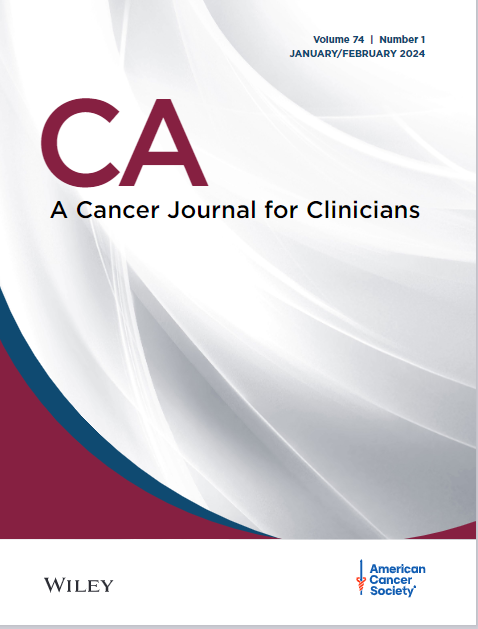Reirradiation: Standards, challenges, and patient-focused strategies across tumor types
IF 232.4
1区 医学
Q1 ONCOLOGY
引用次数: 0
Abstract
Reirradiation (reRT), defined as administering a course of radiation therapy to a specific area previously irradiated, is an evolving treatment strategy for locoregionally recurrent cancer that offers significant potential and poses inherent challenges. Advances in such techniques as intensity-modulated and stereotactic body radiation therapy have improved precision, making reRT a viable option for complex scenarios previously deemed high-risk. Nevertheless, reRT remains associated with substantial risks—including life-threatening side effects, functional impairments, and psychosocial effects—which must be carefully balanced against the patient's overall health and the likelihood of achieving cancer control or palliation. Patient selection is essential to optimize outcomes while mitigating risks. Decisions should account for tumor characteristics at the time of primary diagnosis and recurrence, elapsed time since prior treatment, the possibility of delivering meaningful doses to the tumor, and the cumulative irradiation tolerance of normal tissues. Advanced imaging modalities, such as functional magnetic resonance imaging and fluorine-18–labeled fluorodeoxyglucose–positron emission tomography, are important for distinguishing recurrences from treatment-induced changes, refining treatment targets, and minimizing exposure to healthy tissue. Combined treatment with systemic regimens—targeted therapies and immunotherapy in particular—offers promising opportunities but requires coordination to manage side effects. Standardized guidelines, such as those from the European Society of Therapeutic Radiology and Oncology-European Society for Research and Treatment of Cancer, are essential for improving the consistency of reporting, guiding clinical decision making, and fostering patient-centered care. Multidisciplinary collaboration and ongoing research, particularly through clinical trials, are central to fully exploiting reRT strategies. In addition, the development of innovative techniques, such as proton therapy, would likely enable safer treatments. These efforts aim to improve the therapeutic balance of reRT, enhancing outcomes and quality of life.再照射:肿瘤类型的标准、挑战和以患者为中心的策略
再照射(ret),定义为对先前照射过的特定区域进行一个疗程的放射治疗,是一种不断发展的局部复发性癌症治疗策略,具有巨大的潜力,也带来了固有的挑战。调强和立体定向身体放射治疗等技术的进步提高了精度,使rt成为以前被认为是高风险的复杂情况的可行选择。然而,rt仍然与重大风险相关,包括危及生命的副作用、功能障碍和心理社会影响,必须仔细权衡患者的整体健康状况和实现癌症控制或缓解的可能性。患者选择对于优化结果和降低风险至关重要。决定应考虑肿瘤在初次诊断和复发时的特征,自先前治疗以来的时间,向肿瘤提供有意义剂量的可能性,以及正常组织的累积辐照耐受性。先进的成像方式,如功能磁共振成像和氟-18标记的氟脱氧葡萄糖正电子发射断层扫描,对于区分复发和治疗引起的变化,细化治疗靶点和最大限度地减少对健康组织的暴露非常重要。与全身疗法联合治疗,特别是靶向治疗和免疫治疗,提供了很有希望的机会,但需要协调以控制副作用。标准化的指南,例如来自欧洲治疗放射学和肿瘤学学会-欧洲癌症研究和治疗学会的指南,对于提高报告的一致性、指导临床决策和促进以患者为中心的护理至关重要。多学科合作和正在进行的研究,特别是通过临床试验,是充分利用应急战略的核心。此外,创新技术的发展,如质子治疗,可能会使更安全的治疗。这些努力旨在改善rt的治疗平衡,提高疗效和生活质量。
本文章由计算机程序翻译,如有差异,请以英文原文为准。
求助全文
约1分钟内获得全文
求助全文
来源期刊
CiteScore
873.20
自引率
0.10%
发文量
51
审稿时长
1 months
期刊介绍:
CA: A Cancer Journal for Clinicians" has been published by the American Cancer Society since 1950, making it one of the oldest peer-reviewed journals in oncology. It maintains the highest impact factor among all ISI-ranked journals. The journal effectively reaches a broad and diverse audience of health professionals, offering a unique platform to disseminate information on cancer prevention, early detection, various treatment modalities, palliative care, advocacy matters, quality-of-life topics, and more. As the premier journal of the American Cancer Society, it publishes mission-driven content that significantly influences patient care.

 求助内容:
求助内容: 应助结果提醒方式:
应助结果提醒方式:


